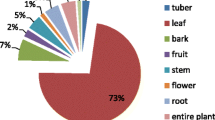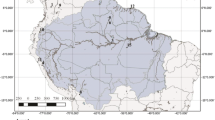Medicinal Plant Trade in Northern Kenya: Economic Importance, Uses, and Origin
Despite the importance of the medicinal plant trade in Africa, little is known about the existing trade in Kenya outside major urban centers. We assessed the economic importance, uses, and origins of the plants traded in two major towns in northern Kenya. We interviewed vendors, assessed volumes and prices, and collected specimen samples for identification. We also discussed with collectors and made observations on harvesting techniques and species’ relative abundance in the wild. Thirty species were found to be traded in Marsabit and Moyale towns, of which only Myrsine africana L. was collected in a forest. The seven most frequently traded species accounted for an annual volume of 5500 kg with an annual retail value of US$25,900. Several uses mentioned by vendors had not been previously reported in the literature. Interestingly, some species high in demand in major urban centers are abundant in these montane forests. Our study highlights the substantial economic importance of the medicinal plant trade in the area and the strong effect ethnicity has on plant use. While more research is needed on the previously undocumented uses of certain plant species, it seems that the trade of certain species could be further promoted.





Similar content being viewed by others
Literature Cited
Afzal, M., M. Ali, M. Thomson, and D. Armstong. 2000. Garlic and its medicinal potential. Inflammopharmacology 8:123–148.
Arnold, J. E. M. and M. Ruiz-Perez. 2001. Can non-timber forest products match tropical forest conservation and development objectives? Ecological Economics 39:437–447.
Assogbadjo, A. E., R. Glèlè Kakaï, F. G. Vodouhê, C. A. M. S. Djagoun, J. T. C. Codjia, and B. Sinsin. 2012. Biodiversity and socioeconomic factors supporting farmers’ choice of wild edible trees in the agroforestry systems of Benin (West Africa). Forest Policy and Economics 14:41–49.
Azam, S., S. Bashir, and B. Ahmad. 2011. Anti-spasmodic action of crude metabolic extract and a new compound isolated from the aerial parts of Myrsine africana. BMC Complementary and Alternative Medicine 11:55.
Beentje, H. 1994. Kenya trees, shrubs and lianas. National Museums of Kenya, Nairobi.
Bussmann, R. W. 2002. Islands in the desert—a synopsis of the forest vegetation of Kenya’s northern, central and southern mountains and highlands. Journal of East African Natural History 91:27–79.
——— 2006. Ethnobotany of the Samburu of Mt. Nyiru, South Turkana, Kenya. Journal of Ethnobiology and Ethnomedicine 2:35.
Cuni-Sanchez, A., M. Pfeifer, R. Marchant, and N. D. Burgess. 2016. Ethnic and locational differences in ecosystem service values: insights from the communities in forest islands in the desert. Ecosystem Services 19:42–50.
Cunningham, A. B. 1993. African medicinal plants: setting priorities at the interface between conservation and primary healthcare. in People and Plants Initiative. UNESCO, Paris.
Dietz, T., W. R. Adano, and K. Witsenburg. 2015. Natural resources and conflicts: theoretical flaws and empirical evidence from northern Kenya. Africa Environmental Review Journal 2:16–31.
Fratkin, E. and E. A. Roth. 2005. The setting—pastoral sedentarization in Marsabit District, northern Kenya. Pages 29–52 in E. Fratkin and E. A. Roth, eds., As pastoralists settle—social, health, and economic consequences of the pastoral sedentarization in Marsabit District, northern Kenya. Studies in human ecology and adaptation. Kluwer Academic, New York.
Gaoue, O. G. and T. Ticktin. 2007. Patterns of harvesting foliage and bark from the multipurpose tree Khaya senegalensis in Benin: variation across ecological regions and its impacts on population structure. Biological Conservation 137:424–436.
Gathuma, J. M., J. M. Mbaria, J. Wanyama, H. F. A. Kaburia, L. Mpoke, J. N. Mwangi, and Samburu and Turkana healers. 2004. Efficacy of Myrsine africana, Albizia anthelmintica and Hilderbrantia sepalosa herbal remedies against mixed natural sheep helminthosis in Samburu district, Kenya. Journal of Ethnopharmacology 91:7–12.
Githae, E. W., M. Chuah-Petiot, J. K. Mworia, and D. W. Odee. 2008. A botanical inventory and diversity assessment of Mt. Marsabit forest, a sub-humid montane forest in the arid lands of northern Kenya. African Journal of Ecology 46:39–45.
Government of Kenya 2011. Vision 2030 Development strategy for northern Kenya and other arid lands, final report. See www.vision2030.go.ke (accessed 10.10.2015.).
Hamilton, A. C. 2004. Medicinal plants, conservation and livelihoods. Biodiversity Conservation 13:1477–1517.
Jusu, A. and A. Cuni-Sanchez. 2013. Economic importance of the medicinal plant trade in Sierra Leone. Economic Botany 67:299–312.
——— and ———. 2014. Medicinal plant trade in Sierra Leone: threats and opportunities for conservation. Economic Botany 68:16–29.
Kokwaro, J. O. 2009. Medicinal plants of East Africa, 3rd edition. University of Nairobi Press, Nairobi.
Kuria, M. W., P. K. Njenga, and V. W. Ngumi. 2012. Ethnobotanical studies of Strychnos henningsii in five natural habitats in Kenya. International Journal of Medicinal Plant Research 1:063–074.
Leach, M. and K. Saravana. 2008. The clinical effectiveness of ginger (Zingiber officinale) in adults with osteoarthritis. International Journal of Evidence-Based Healthcare 6:311–320.
Maundu, P. and B. Tengnäs. 2005. Useful trees and shrubs for Kenya. World Agroforestry Centre–Eastern Central Africa Regional Program (ICRAF-ECA), Nairobi.
McGeoch, L., I. Gordon, and J. Schmitt. 2008. Impacts of land use, anthropogenic disturbance, and harvesting on an African medicinal liana. Biological Conservation 141:2218–2229.
McMillen, M. 2012. Ethnobotanical knowledge transmission and evolution: the case of medicinal markets in Tanga, Tanzania. Economic Botany 66:121–131.
Moon, M., H. G. Kim, J. G. Choi, H. Oh, P. K. J. Lee, S. K. Ha, S. Y. Kim, Y. Park, Y. Huh, and M. S. Oh. 2014. 6-Shogaol, an active constituent of ginger, attenuates neuro inflammation and cognitive deficits in animal models of dementia. Biochemical and Biophysical Research Communications 449:8–13.
Muriuki, J., S. Franzel, J. Mowo, P. Kariuki, and R. Jamnadass. 2012. Formalisation of local herbal product markets has potential to stimulate cultivation of medicinal plants by smallholder farmers in Kenya. Forests, Trees and Livelihoods 21:114–127.
Nagourney, R. A. 1998. Garlic: medicinal food or nutritious medicine? Journal of Medicinal Food 1:13–28.
Namukobe, J., J. M. Kasenene, B. T. Kiremire, R. Byamukama, M. Kamatenesi-Mugisha, S. Krief, V. Dumontet, and J. D. Kabasa. 2011. Traditional plants used for medicinal purposes by local communities around the Northern sector of Kibale National Park, Uganda. Journal of Ethnopharmacology 136:236–245.
Ngene, S. M., H. Van Gils, S. E. Van Wieren, H. Rasmussen, A. K. Skidmore, H. H. T. Prins, A. G. Toxopeus, P. Omondi, and I. Douglas-Hamilton. 2009. The ranging patterns of elephants in Marsabit protected area, Kenya: the use of satellite-linked GPS collars. African Journal of Ecology 48:386–400.
Njoroge, G. N. 2012. Traditional medicinal plants in two urban areas in Kenya (Thika and Nairobi): diversity of traded species and conservation concerns. Ethnobotany Research and Applications 9:329–338.
——— and R.W. Bussmann 2006. Phytotherapeutic management of malaria in the central highlands of Kenya. Journal of Ethnobiology and Ethnomedicine 2:1:8.
Peters, C. M. 1996. The ecology and management of non-timber resources, World Bank Technical Paper 322. The World Bank, Washington, DC.
Posthouwer, C. 2015. Medicinal plants of Kariakoo Market, Dar es Salaam, Tanzania. MsC Research Project Report, Leiden University. The Netherlands.
Quiroz, D., A. Towns, S. I. Legba, J. Swier, S. Brière, M. Sosef, and T. van Andel. 2014. Quantifying the domestic market in herbal medicine in Benin, West Africa. Journal of Ethnopharmacology 151:1100–1108.
Rajkumar, M., R. H. Chandra, K. Asres, and C. Veeresham. 2008. Toddalia asiatica (Linn.) Lam.—a comprehensive review. Pharmacognosy Reviews 2:386–397.
Rehmann, N., A. Khan, K.M. Alkharfy, and R. Gilani. 2012. Pharmacological basis for the medicinal use of Lepidium sativum in airways disorders. Evidence-Based Complementary and Alternative Medicine Article ID 596524.
Santosh, B. S., A. Ganeshpurkar, J. Narwaria, G. Rai, and A. Jain. 2011. Tamarindus indica: extent of explored potential. Pharmacognosy Review 5:73–81.
Schmelzer, G. H. and A. Gurib-Fakim. 2008. Plant Resources of Tropical Africa (PROTA) 11(1): Medicinal Plants 1. PROTA Foundation, Wageningen, the Netherlands.
Sheldon, J. W., M. J. Balick, and S. A. Laird. 1997. Medicinal plants: can utilization and conservation coexist? Advances in Economic Botany 12. The New York Botanical Garden, New York.
Shibia, M. G. 2010. Determinants of attitudes and perceptions on resource use and management of Marsabit National Reserve, Kenya. Journal of Human Ecology 30:55–62.
Sombroek, W. G., H. M. H. Braun, and H. M. H. van der Pouw. 1982. Exploratory soil map and agroclimatic zone map of Kenya, 1980. Scale: 1:1’000’000. Exploratory Soil Survey Report No. E1. Kenya Soil Survey Ministry of Agriculture - National Agricultural Laboratories, Nairobi, Kenya.
Stanley, D., R. Voeks, and L. Short. 2012. Is non-timber forest product harvest sustainable in the less developed world? A systematic review of the recent economic and ecological literature. Ethnobiology and Conservation 1:9.
Stewart, K. 2009. Effect of bark harvest and other human activities on populations of the African cherry (Prunus africana) on Mount Oku, Cameroon. Forest Ecology and Management 258:1121–1128.
Stewart, K. M. and D. Cole. 2005. The commercial harvest of devil’s claw (Harpagophytum spp.) in southern Africa: the devil’s in the details. Journal of Ethnopharmacology 14:225–36.
Towns, A. M. 2014. Fertility and Fontanels: Women’s Knowledge of Medicinal Plants for Reproductive Health and Childcare in Western Africa. PhD thesis, Leiden University, the Netherlands. https://openaccess.leidenuniv.nl/handle/1887/28942.
———, D. Quiroz, L. Guinee, H. de Boer, and T. van Andel. 2014. Volume, value and floristic diversity of Gabon’s medicinal plant markets. Journal of Ethnopharmacology 155:1184–1193.
van Andel, T. and R. Havinga. 2008. Sustainability aspects of commercial medicinal plant harvesting in Suriname. Forest Ecology and Management 256:1540–1545.
———, B. Myren, and S. van Onselen. 2012. Ghana’s herbal market. Journal of Ethnopharmacology 140:368–378.
Williams, V. L., E. T. F. Witkowski, and K. Balkwill. 2007. Volume and financial value of species traded in the medicinal plant markets of Gauteng, South Africa. International Journal of Sustainable Development and World Ecology 14:584–603.
World Health Organization 2003. Traditional medicine. Factsheet No. 134.
Zou, Y., C. Tan, B. Wang, D. Zhu, and S. Kim. 2008. Chemical constituents from Myrsine africana L. Helvetica Chimica Acta 91:2168–2173.
Acknowledgements
We are deeply grateful to our study participants who graciously shared their time and knowledge. We are also thankful to our field assistants and translators, W. Galgalo, A.M. Aide, H. Lerapo, J. Harugura, M. Galgalo, R.A. Wamuro, S. Wasapicho, and M. Kirimania, for making this research possible, and to P.Ch. Mutiso at the School of Biological Sciences, University of Nairobi, for helping with plant identification. We also thank the kind support given by L. Olaka, B. Mamo, and NEMA Marsabit Office, T. Kinyua and WARMA Marsabit Office, H.K. Walaga and KALRO-Marsabit, S. Rucina and NMK, and the British Institute in Eastern Africa (BIEA). This research was partially funded by Marie Curie Actions Intra-European Fellowships (IEF, no. 328075).
Author Contributions
ACS conceived the study. ASD and ACS collected and analyzed the data with input from NDB. ASD wrote the paper with input from ACS and NDB.
Author information
Authors and Affiliations
Corresponding author
Additional information
1Received ________; accepted ________; published online ________.
Rights and permissions
About this article
Cite this article
Delbanco, AS., Burgess, N.D. & Cuni-Sanchez, A. Medicinal Plant Trade in Northern Kenya: Economic Importance, Uses, and Origin1 . Econ Bot 71, 13–31 (2017). https://doi.org/10.1007/s12231-017-9368-0
Received:
Accepted:
Published:
Issue Date:
DOI: https://doi.org/10.1007/s12231-017-9368-0




